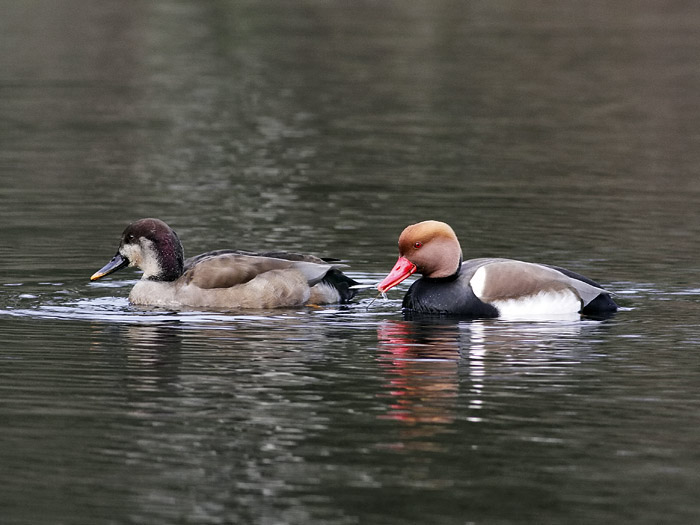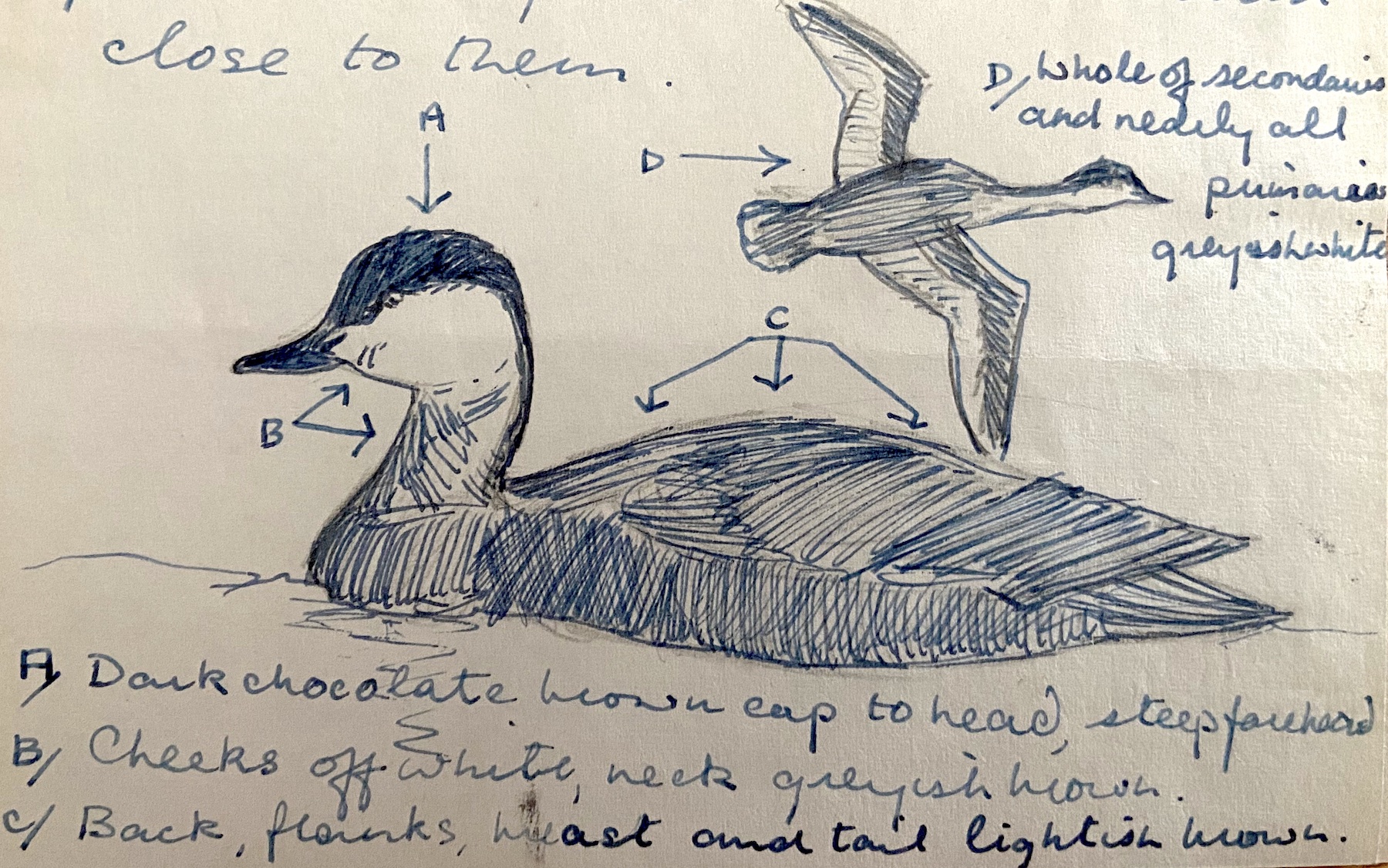Red-crested Pochard Netta rufina (RBBP)
Scarce winter visitor and very scarce breeding species. Increasing numbers of feral birds present in the county, especially in the south-west.

Red-crested Pochard at Swanholme, Lincoln on January 11th 2012 (Russell Hayes).
Historically, a male shot in January 1826 was the second British record. Another was shot in the same district in 1854. There were no further records until April 1937 when five were present at Tetney. A pair established a territory and a nest containing four eggs was found on May 19th; there were six on a later date, but rats eventually destroyed the clutch. This was the first documented record of the species breeding in Britain. These birds were considered to have escaped from the waterfowl collection at Woburn Park in Bedfordshire, where this species has bred and had been allowed to fly freely for a number of years before this date. It is noteworthy that a spread in the breeding range to northwest Europe occurred close to this time and breeding was first reported in Denmark and the Netherlands in the early 1940s. Regardless of this, the population in Britain has mostly originated from releases or escapes from waterfowl collections (BTOA).
After the early sightings, further records occurred on November 24th 1957 (L.N.E.R. Pit, Lincoln); November – December 1959 (at least three at Tallington Pits, near Stamford); May 16th – 23rd 1960 (one at Langtoft Pit). At the time of the 1957 record the Wildfowl Trust suggested that all records of this species must be considered as escapes from captivity, but they also noted that the date coincided with that at which western European birds disperse (particularly from Holland where autumn concentrations disperse in October and November to unknown destinations). There were no more records until 1967, but since then they have occurred almost annually and sightings are gradually increasing - in 2016 there were 64 records from 15 areas in Lincolnshire. Inland records still predominate and the species is a very rare visitor to the coast. Baston-Langtoft Pits are the principal site for this species and a count of 95 there on November 2nd 2016 exceeded the previous best count of 67 in the same location in October 2011. Sightings from this location date back to the 1960s and it is reported that birds were released at this site by the owner in 1991 and 1992, with two pairs present in winter 1993 suspected of being from this source. Summering was noted at this locality in 1995 and the following year a pair bred raising two young – the first successful breeding in a wild state in Lincolnshire for 59 years. Around eight pairs bred i n 2018 and six in 2019. Naturally vagrancy from continental Europe doubtless occurs, but the introduced population has undoubtedly masked the true status.
The species has expanded greatly across Britain since the late 1960s and interestingly there has been a parallel increase in central Europe following a range shift from the western Mediterranean to Switzerland and Germany. It is conceivable that birds of wild origin have supplemented the early colonisers of captive origin. ). There remains just a single recovery of a British-ringed bird abroad; a first-year bird ringed on September 1st 1952 at St. James's Park, London was found dead 472km ENE at Hoogeveen, Drente, Netherlands on January 3rd 1953. There are no recoveries of foreign-ringed birds in the UK to date.
Finder’s report: Red-crested Pochard Goose at Langtoft, May 15th, 1960: an early county record.
by R. L. K. Joliffe and P. J. Tizzard.
Note: this account is based an original RC submission at the time. There are earlier county records in the LBC archive (see above), but the species was considered by the RC at the time (and until 1963). The RC noted that there can scarcely be any doubt that the concentration that was observed at at Abberton Reservoir in 1960, as in earlier years, was of wild birds from Holland or the Baltic. On the other hand, some of the inland occurrences are perhaps more likely to refer to escapes than to wild birds.
Note from R. J. K. Joliffe to the RC
I enclose a diagram and description of a female Red-crested Pochard seen at Langtoft GP, Lincolnshire on Sunday May 15th, 1960. I am fully aware that all records of the above species are to be regarded with extreme suspicion owing to the numbers of them which are kept in wildfowl collections. However, I have made a check at all private collections which contain Red-crested Pochard as well as at the Wildfowl Trust gardens at Peakirk and so far have found that there have been no escapes of this duck. I would be very grateful for your views as to whether this bird is an escapee e.g., from Woburn or St. James’ Park, as it could be counted as an authentic record of a wild bird.
Circumstances and description
The above species (Red-crested Pochard) was observed at Langtoft GP, Lincolnshire, between the hours of 10.00 and 11.00 GMT by P. J. Tizzard and R. L. K. Joliffe. The duck was accompanied by several pairs of Tufted Duck and a few male Mallard, I t’s size noted as being roughly intermediate with the latter two species. On the whole the duck was wary and taking to flight with little provocation and in fact sooner than any of the other ducks p resent. The body was well above the surface of the water and when wary, the neck would be stretched up, making it appear fairly long. On taking to flight a very short patter was undertaken.
The area frequented by the duck in question consisted of two pits each roughly 200 yd. wide and bordered by fairly dense reeds etc. Into these the Red-crested Pochard was seen to enter on occasions, while for the most part it would swim close to them.

Sketch of the Red-Crested Pochard at Langtoft GP from the original RC submission.
(Account from LBR records and as per new Birds of Lincolnshire (2021), included September 2022)
